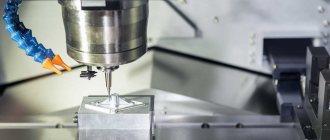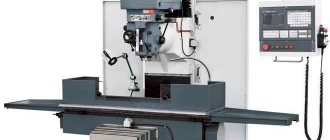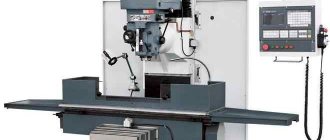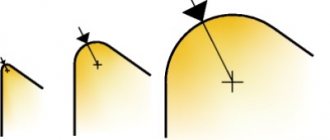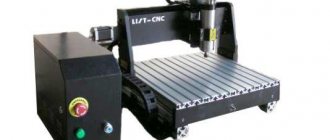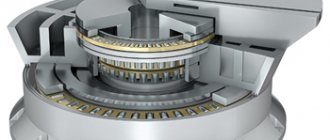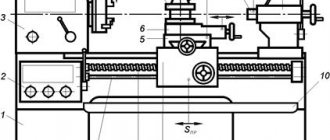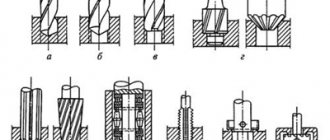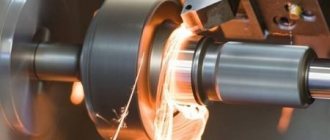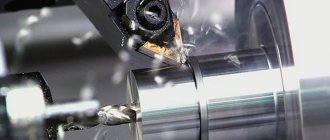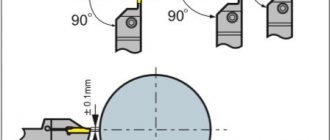Since ancient times, humanity has been using metals and their alloys; They are used to make weapons, jewelry, household utensils, tools and various parts. In order for a metal ingot to turn into a product people need, a lot of effort is required: the workpiece must be processed, changing its shape and size, as well as physical and chemical properties. Over the long period of time since the discovery of metals, many methods of processing them have been created.
Basic methods of metal processing
The differences between metalworking methods lie in what equipment and technologies are used. The main processing methods are the following:
- Mechanical (carried out using pressure and cutting).
- Thermal.
- Art.
- Electric.
- Turning.
- Welding.
- Casting.
Parallel/waterline trim combination
Many CAM programs that offer both parallel and waterline machining also have a way to limit their use to certain areas based on surface angles. Below is a screenshot of a tool path from MeshCAM with a threshold angle of 45 degrees. Everything below 45 is processed in parallel, everything steeper is the waterline.
Combined processing of parallel line and waterline
The simulation shows only one problem area:
Parallel modeling and waterline modeling
The corners could have been cleaned up a bit more and it would have been easier to have a machine do it rather than us having to do it by hand.
Metal processing under pressure
With this processing method, the shape and dimensions of the product change during the deformation process. The method has a number of advantages:
- Improvement of metal structure.
- Increasing the physical and mechanical properties of the material.
- Giving the alloy chemical homogeneity.
- Minimization of shrinkage porosity.
- Increasing the strength and elasticity of metal.
How will the metal be processed? It depends on which technology is chosen. The main pressure processing methods are listed in the table below:
| Process | Target | Kinds |
| Rolling | Reducing the geometric parameters of the cross section of a part, giving the required configuration | transverse; longitudinal; cross-helix |
| Forging | Creating a part with a specific shape using high-temperature heat and tools | hand forging; stamping; forging using equipment |
| Pressing | Metal extrusion on equipment with a replaceable matrix | Hot/cold pressing |
| Drawing | Formation of a product with a given cross-sectional profile | dry/wet; roughing/finishing; single/multiple; cold/hot |
| Volume stamping | Obtaining a product of the desired configuration using a stamp | Open/closed die processing process |
| Sheet stamping | Creating a part using a hydraulic or crank press | separate; formative |
Separately, it should be noted the cold processing of metal under pressure. This method allows you to change the physical and chemical characteristics of products, give them the desired shape and size, while maintaining the integrity of the material.
What it is
Cutting mode most often refers to characteristics that are found by calculation. These are depth, speed and serve. These values are very important. Without them, it is simply impossible to qualitatively turn any part.
When calculating operating modes, other characteristics of the work manipulations performed are also taken into account:
If necessary, many other characteristics of those elements that affect the processing of parts are taken into account.
Cutting
In cutting machining, a cutting tool is used to produce parts. After the top layer of metal is cut off, a workpiece of a given accuracy is obtained, having a certain shape and roughness. The layers are removed on a metal-cutting machine. Long rolled metal is used as the material for the workpieces. The main types of cutting include:
- Manual processing.
A gas welder uses a gas torch to cut metal into pieces of the required size and shape. This method is used by pilot production or small workshops. - Gas flame treatment.
The flame created by a special installation quickly cuts the metal sheet. This method allows the resulting workpieces to be laid out in containers (then they are delivered to assembly points). - Laser processing.
The metal is cut with a laser beam. Laser processing is not only highly accurate, but also reduces waste. In addition, lasers are used for welding and engraving. - Plasma treatment.
A plasma torch (highly ionized gas) cuts sheets of hard or special alloys. - Waterjet processing.
A jet of water with an abrasive is used to cut metal. Water passing through a narrow hole under high pressure reaches a speed of 900 meters per minute and cuts the material. The process is controlled by computer programs.
Characteristics of operating modes
The calculation of the cutting operation is carried out using special reference and regulatory documents, of which there are quite a few at the moment. It is necessary to carefully study the tables presented and select the appropriate values in them. A correctly performed calculation guarantees the high efficiency of the applied part processing mode and ensures the achievement of the best result.
But this method of calculation is not always successful, especially in production conditions, when it is inappropriate to spend a lot of time studying tables with a huge number of values. It has been established that all values of cutting modes are interrelated. If you change one value, it is natural that all other processing characteristics will become different.
Therefore, very often specialists prefer to use calculation or analytical methods for determining cutting conditions. Special empirical formulas are used to determine all the necessary standards. In order for the calculations using this method to be absolutely accurate, you need to know the following parameters of the lathe:
In modern industries, special software is used to perform such calculations. The specialist just needs to enter the known data, after which the computer will produce the calculated values. The use of calculation programs greatly facilitates the work of specialists and makes production more efficient.
Heat treatment
Heat treatment is a sequence of heating, holding and cooling the metal. Thermal processing is needed to change the structure of the material and give the workpiece the necessary physical and mechanical properties. Blanks are made from steel and non-ferrous metals.
Types of heat treatment:
- Annealing of the 1st or 2nd kind.
The metal is heated to the desired temperature, then subjected to aging and cooling, resulting in a material with an equilibrium structure. The metal acquires more viscosity and ductility, while its hardness and strength decreases. - Hardening.
This type of processing is divided into two subtypes - with and without polymorphic transformation. Hardening increases the strength and hardness of the metal due to the formation of a nonequilibrium structure. This treatment is applied to alloys that undergo phase changes in the solid state when heated and cooled. - Tempering
is a method developed for hard steels and hardened alloys. Key parameters are heating temperature, holding period and cooling rate. - Aging.
Alloys that have undergone quenching without polymorphic transformation are subjected to aging. This type of heat treatment can increase the strength and hardness of steels made of aluminum, magnesium, copper and nickel. - Chemical-thermal treatment
, changing the chemical composition, structure and characteristics of the surface of the product. After such treatment, the metal becomes more wear-resistant and hard, acquires fatigue resistance and contact endurance, as well as anti-corrosion properties. - Thermo-mechanical treatment.
During the process, the material undergoes plastic deformation, which makes it possible to create an increased density of defects in the crystal structure of the workpiece. Aluminum and magnesium alloys are processed in this way.
What it is
Cutting mode most often refers to characteristics that are found by calculation. These are depth, speed and serve. These values are very important. Without them, it is simply impossible to qualitatively turn any part.
When calculating operating modes, other characteristics of the work manipulations performed are also taken into account:
If necessary, many other characteristics of those elements that affect the processing of parts are taken into account.
Welding, electrical and turning processing methods
Using welding, a permanent connection of steel parts is achieved by heating the metal to a melting or highly plastic state. The material melted along the edge of the joined parts is mixed, and when it hardens, a seam is formed. There are electric (arc and contact) and chemical (gas and thermite) welding.
Electrical metalworking is divided into two types:
- Electric spark processing, based on the destructive effect of electric spark discharges on durable metals.
- Ultrasonic processing is a method created for working with hardened steel, hard alloys, precious stones and other materials.
Turning is the name for manual work on a machine. In the process, the excess layer is removed from the parts, and they acquire the desired shape, accuracy, roughness and size. The choice of type of processing depends on the purpose of the work (main work, repair, assembly).
Metal processing is necessary for the production of blanks and parts that are required for mechanical engineering, aviation, the automotive industry and other industries.
Technological diagrams
The stage of the technological process - mechanical processing of workpieces - includes the following operations: creating base surfaces, processing to size in thickness and width, facing, forming tenons and lugs, milling, drilling holes, making oblong sockets and holes, turning, grinding.
In the production of wood products, there are a number of technological schemes for mechanical processing of bar blanks. Let us present the most typical of them.
- Creation of base surfaces on jointing machines - processing to size on thicknessing machines - facing on cross-cutting machines or end levelers - selection of elongated slots and holes on drilling-grooving or chain-slotting machines - grinding.
- Creation of base surfaces on jointing machines - processing to size on thicknessing machines - forming tenons (eyes) and facing on tenoning machines - grinding.
- Creation of base surfaces on jointing machines - processing to size on thickness planers - profile milling on longitudinal milling machines - trimming - forming tenons (eyes), or drilling holes, or selecting oblong sockets and holes - grinding.
- Creation of base surfaces on jointing machines - processing to size (if necessary, and profile formation) on four-sided longitudinal milling machines - trimming - forming tenons (eyes), or drilling holes, or selecting oblong sockets and holes - grinding.
- Processing to size on thicknessing machines - profile milling on milling machines - trimming - forming tenons (eyes), or drilling holes, or making oblong sockets and holes - grinding.
- Processing to size on thicknessing machines – facing – making oblong sockets and holes – drilling holes – grinding.
- Processing to size on thicknessing machines - forming tenons (eyes) and trimming on tenoning machines - drilling holes - grinding.
- Processing to size (if necessary, profile formation) on four-sided longitudinal milling machines – facing – selection of oblong slots and holes – grinding.
- Processing to size on four-sided longitudinal milling machines - forming tenons (eyes) and facing on tenoning machines - drilling holes - grinding.
- Creation of base surfaces - processing to size - forming tenons and lugs - trimming - drilling holes - selecting oblong sockets and holes on production, automatic and semi-automatic lines.
An analysis of the given technological schemes for machining workpieces is given below.
Pencil finish
Penciling has the sole purpose of running the cutter along sharp concave corners to clean them up. Outside corners or convex corners are handled very well using a combination of parallelism and waterline, so pencil finishing is not a big deal here.
As a rule, there are no settings for it; just set the feed speed, the tool and turn it on. This is what it looks like:
Pencil trajectory
When we add a pencil path to the above combination of parallel waterlines, we get the following:
Pencil modeling
Since pencil paths are short compared to parallel or waterline paths, it's almost always worth using them if you have a piece with sharp concave corners.
